Purpose Driven
When Ford Motor Co. invited me down to Fort Worth in late September, I spent two days driving around the Texas countryside, kicking the tires, pushing the pedals and pulling out all the stops on Ford’s next generation F-150 trucks. The company released four new gas engines, standard six-speed transmissions and cool new technologies like EPAS and tow/haul at the event, touting its F-150 as the most popular truck for the last 33 years.
I hauled trailers, went drag racing, grilled engineers, talked with marketing experts and even took a few photos along the way. The Texas Motor Speedway was the backdrop for the event — a magnate for power, speed and driving enthusiasts. At the north end of Fort Worth, the 1.5-mile oval track is known for its high banks, big speeds and wealth of NASCAR winners from Dale Earnhardt Jr. to Tony Stewart to Kurt Busch.
Ford Motor Co. decided to capitalize on the track’s victorious momentum, introducing four new powertrains to its F-150 lineup. Two different waves of editors, writers and truck and trailer aficionados flew into Fort Worth to test drive the new trucks, engines and transmissions. In fact, it was the most extensive powertrain overhaul in the 62-year history of the Ford F-Series. The engine lineup includes four new truck engines: a 3.7-liter V6; 5.0- and 6.2-liter V8s; and a twin-turbocharged 3.5-liter EcoBoost (also a V6). Headlining that engine lineup is the uniquely named EcoBoost, which Ford says will deliver an unbeatable combination of best-in-class towing (11,300 lbs), payload (3,060 lbs) and torque (420 lb-ft), while giving customers the fuel economy of a V6.
“Truck customers should think of the EcoBoost truck engine as a gas-powered engine with diesel-type capability and characteristics,” says Jim Mazuchowski, V6 engines program manager. “The twin turbochargers and direct injection give it the broad, flat torque curve that makes towing with a diesel so effortless and hard acceleration so much fun.”
The key EcoBoost technologies are definitely turbocharging and direct fuel injection. The combination
delivers a wealth of low-end torque and maintains it across a broad rpm range (1,700 to 5,000 rpm), which is key in hauling applications. The best-in-class towing of 11,300 lbs is more than enough to haul a fully loaded three-horse trailer or a Bobcat 630 skid steer with a couple of attachments. Along with that power, the EcoBoost’s twin independent variable camshaft timing (Ti-VCT) creates precise, variable timing control of both the intake and exhaust camshafts to optimize power, performance and fuel economy. Overall, the 3.5-liter EcoBoost will have up to 20 percent better fuel economy compared with the outgoing 2010 F-150, says Ford. That’s pretty impressive, to say the least. And the EcoBoost is only one of many cool new innovations from the forward thinkers at Ford.
Behind the 8-Ball
The United States can be considered the home of the V8 — it has always been more popular here than anywhere else. But the famous V styled engine with eight cylinders has lost a lot of popularity in the last few years in North America (chided as an expensive gas guzzler). Four- and six-cylinder engines have marched up further to solidify the market dominance of lower cylinder count powertrains.
According to Ward’s Automotive, nearly 62 percent of cars produced in 2009 carried four bangers, up 10 percent in just a year from 2008’s 51.7 percent. Despite the V8 engine’s precipitous fall from on high (it was fitted to 88 percent of all cars sold in 1969), there’s still a sweet spot for these bigger power plants — especially when they’re crafted for trucks with efficiency and power in mind.
Ford Motor Co. released two new V8 engines for its F-150 lineup — a 5.0-liter, four-valve, dual-overhead-camshaft Ti-VCT V8 and a 6.2-liter, two-valve, single-overhead-camshaft V8. The new 5.0-liter is the main V8 offering in the 2011 F-150, boasting many best in classes compared with competitors’ standard V8s, including: best-in-class 360 hp at 5,500 rpm; best-in-class 380 lb-ft of torque at 4,250 rpm; and best-in-class 10,000 lbs maximum trailer tow. While this 5.0-liter V8 engine is similar to the one powering the 2011 Mustang GT, it has several important differences to optimize it for the harsh duty cycle truck customers demand. First, the camshafts were tuned to improve low-speed torque, which is key to truck customers. Also, the 10.5:1 compression ratio was optimized to reduce knock tendency at lower engine speeds while towing.
The hardware added to the 5.0 specifically for F-150 includes: an additional oil cooler, which helps extend the life of the oil to 10,000-mile intervals; foam covers for the fuel injectors to reduce NVH; and cast exhaust manifolds for improved durability. The new aluminum block is 70 lbs lighter than the 5.4-liter V8, which aids fuel economy and improves handling. The engine’s forged-steel crankshaft also ensures durability.
“This engine uses proven technology to deliver a great combination of low-speed torque and fuel economy with the durability F-150 customers demand,” said Mike Harrison, V8 engine programs manager.
The 6.2-liter V8 is the premium engine offering on the 2011 F-150, with an expanded offering to the cool F-150 SVT Raptor and other specialty applications. Its attributes include best-in-class 411 hp at 5,500 rpm and 434 lb-ft of torque at 4,500 rpm vs. all competitors — not to mention best-in-class 11,300 lbs maximum trailer tow vs. all competitors.
The durability of the engine’s race-proven components and technology was showcased in November 2008 when a 6.2-liter Raptor R not only survived the grueling Baja 1000, it earned a podium finish. The same engine then completed every mile of the 2009 Best in the Desert series.
The 6.2-liter V8 utilizes a large bore and shorter stroke. This approach to creating power has its roots in storied Ford racing engines. The large bore allows for larger intake and exhaust valves for improved engine airflow, and the short stroke allows higher engine speed for increased horsepower.
Because of the large bore size, two spark plugs per cylinder are used to more efficiently burn the fuel-air mixture in the combustion chamber, enabling better fuel economy and increased engine torque. The twin plugs also help maintain a smooth, stable idle. The 6.2-liter V8, standard on the 2011 F-Series Super Duty, is uniquely tuned for the F-150 with a special cam profile. The engine is standard on the 2011 F-150 SVT Raptor and other specialty applications (like Ford’s nice towing package).
“This engine has tons of torque and already has been proven in the field with both the F-150 SVT Raptor and Super Duty,” said Harrison. So it’s a Super Duty engine in a Ford F-150.
Shifting to Commercial Gear Heads
More gears give professionals in trucks more options. Whether you’re towing a mini excavator down a steep mountain grade, plowing snow in a Wisconsin whiteout or hauling supplies and crews over an unpaved jobsite, having an expansive transmission in your work truck allows you to travel faster, smoother and safer, while producing more power and better fuel economy. These were some of the conversations going back and forth between a Ford engineer and myself, as we hauled 6,700-lb trailers down the back roads of Fort Worth.
“The F-150 has a diverse set of customers, so we don’t take a one-size-fits-all approach when matching the transmission to the engine,” said Bryant Grytzelius, 6R80 transmission engineering manager. “With the 3.7-liter engine, for example, that particular transmission has fewer clutch plates compared with the other engines. Everything is sized accordingly for optimum driveability, performance and fuel economy.”
This new six-speed automatic transmission is now standard for each of the four new engines for the 2011 Ford F-150, and Ford is the only manufacturer to offer a six-speed automatic transmission as standard throughout the lineup. The revamped 6R80 transmission provides smoother operation and better fuel economy. It also includes SelectShift Automatic capability, progressive range select and manual mode, allowing customers the convenience of an automatic transmission for routine operation combined with the ability to select and lock gears.
It’s a familiar transmission (with several improvements) that manages the power produced by the all-new engine lineup of the 2011 Ford F-150s. The diverse group of engines, which ranges from a 3.7-liter V6 with advanced valvetrain timing to a 6.2-liter V8, will be mated to the 6R80 six-speed. This tried-and-true gearbox has been upgraded to bring available customer conveniences such as SelectShift capability, which automatically shifts during routine operation and also allows complete manual control.
Also included are progressive range select and manual functions. With progressive range select, a toggle on the shift lever allows the customer to reduce the range of available gears while in drive. When the customer taps down into range select mode, the new available 4.2-in. LCD screen shows the available gears and highlights the current gear state. This feature allows the driver to limit use of upper gears when heavily loaded or while towing on grades. For full manual function, customers also can pull the shift lever into “M” for manual mode and use the same toggle switch to select the gear desired. The display will show the selected gear, and the control system will lock the torque converter and hold that gear for a full manual transmission feel.
The 6R80’s tow/haul mode has been recalibrated to provide better control when hauling a heavy load or towing a trailer, especially when going down grades. The improved system, now integrated into the powertrain control module, uses an array of sophisticated electronic sensors to better predict the driver’s need for a downshift to provide engine braking and enhanced control. A further refinement for 2011 is the addition of a one-way clutch, which allows for smoother 1-2 and 2-1 shifts and faster downshifts and helps improve fuel economy.
Ford says the 6R80 has been through 150,000 equivalent miles of testing cycles that reflect the most extreme-use customers, and the box itself is rated up to 7,000 rpm and the fluid is filled for life. The proof is in the test drive; hauling around the Texas countryside was a breeze. The new six-speed tranny (plus great technologies like tow/haul and progressive range select) took away the white-knuckle experience of hauling heavy loads even while dodging semis doing 70 mph on badly paved Texas highways. Grytzelius sums it up.
“The increased capability and functionality of the transmission, backed by exhaustive testing, will help ensure this next F-150 will deliver everything our customers need and more,” he said.
Keith Gribbins is managing editor of Compact Equipment, based in Peninsula, Ohio.
Eco Challenge
MythBusters Gear Up with an Eco-Friendly Freightliner Hybrid Electric Truck
There are no illusions to dispel about the Freightliner hybrid electric truck. That’s not why the company handed over a M2 106 Hybrid to the folks at Mythbusters. The 2010 Freightliner Business Class hybrid dry van truck will actually haul the Discovery Channel show’s equipment to support the production of new episodes. The science behind the hybrid is solid — an EPA 2010 compliant, diesel-powered Freightliner M2 106 Hybrid equipped with selective catalytic reduction emissions technology and an Eaton parallel hybrid-electric drive unit. This combination offers remarkably low exhaust emissions while delivering a 25 to 40 percent improvement in fuel economy.
“The Freightliner Business Class M2 106 Hybrid is a versatile truck renowned for great maneuverability, reliability, efficiency and driver comfort,” said David Hames, general manager, marketing and strategy for Daimler Trucks North America. “While myth-busting may be a messy and challenging task, delivering the goods on-set won’t be a problem for the Freightliner Business Class M2.”
The MythBusters uncover the truth behind popular myths and legends by mixing scientific method with
gleeful curiosity and old-fashioned ingenuity that often includes custom-built test rigs, explosions and flying crash test dummies. At the end of each episode, myths are rated “busted,” “plausible” or “confirmed.”
“We’ve enjoyed a great working relationship with the team at Freightliner Trucks for many years,” said Jamie Hyneman, host of MythBusters. “They’ve provided vehicles for truck-related myths and have offered use of their proving grounds in Madras, Ore., whenever we need it. That’s remarkable because we have a hard time getting anyone who’s seen the show to loan us anything!”
Radio for the Road
Yahoo! and Ram Truck Launch “Ram Country,” a Branded Country Music Destination
Dodge truckers now have their own radio station (online that is). With the help of Yahoo!, Ram Truck unveiled “Ram Country,” the first dedicated country music site on Yahoo! Music, which will serve as the ultimate online hub for country music and its biggest stars. “Ram Country” is designed to help Ram Truck reach country music fans online and marks the largest single online marketing initiative for the Ram Truck brand.
“Ram Country” (ramcountry.music.yahoo.com) represents the first time Yahoo! has developed a genre-specific music channel with a single advertiser. The new site will allow the Ram Truck brand to connect with a country music fanbase through an engaging mix of music, blogs, news coverage and original video programming produced by Yahoo! “Ram Country” will go live on Yahoo! Music and will be promoted across the Yahoo! network.
“’Ram Country’ showcases the best of online marketing and programming by providing relevant and entertaining branded programming at mass scale,” said Jeff Bronikowski, head of Yahoo! Music. “Country music represents an ideal platform for Ram Truck to reach its target audience and build brand loyalty. It is this type of personalized, content-rich programming that allows Yahoo! to be the center of people’s online lives.”

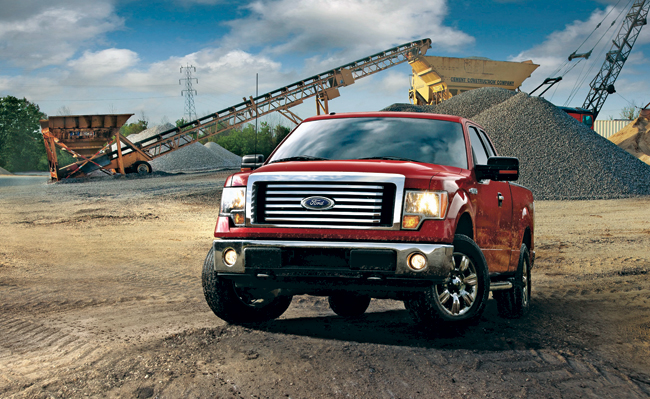
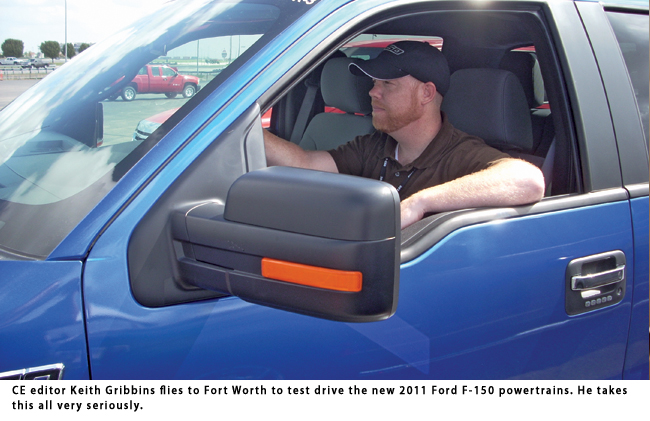
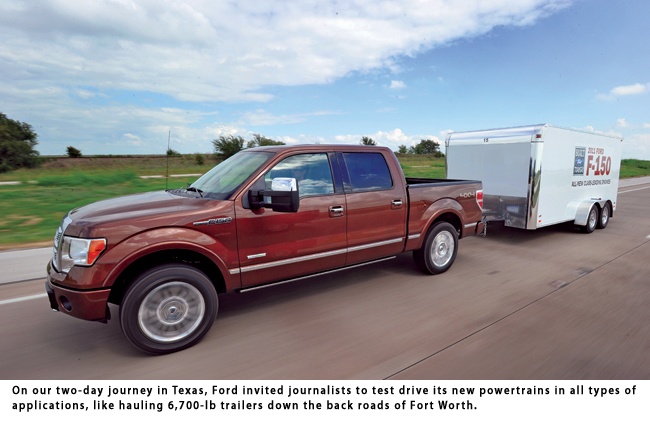
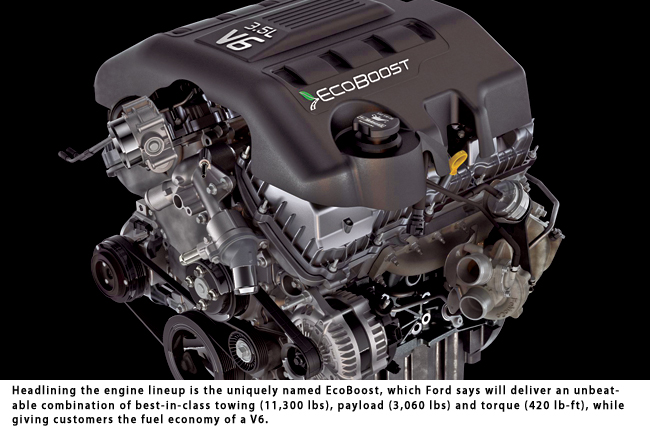
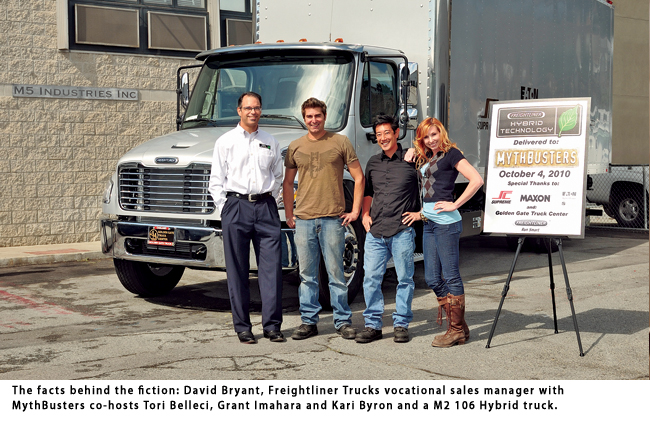
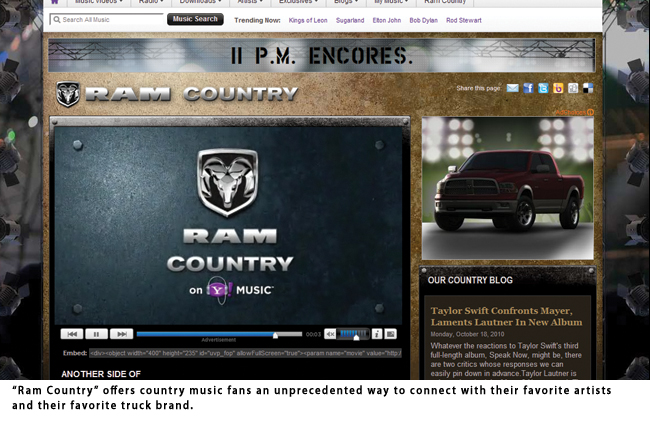
Comments are closed here.